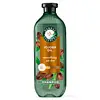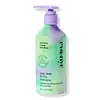What's inside
What's inside
 Key Ingredients
Key Ingredients

No key ingredients
 Benefits
Benefits

 Concerns
Concerns

 Ingredients Side-by-side
Ingredients Side-by-side

Water
Skin ConditioningSodium Cocoyl Isethionate
CleansingLauramidopropyl Betaine
CleansingCocamidopropyl Betaine
CleansingSodium Lauroyl Sarcosinate
CleansingParfum
MaskingCamellia Oleifera Seed Oil
Skin ConditioningAloe Barbadensis Leaf Juice
Skin ConditioningSimmondsia Chinensis Seed Oil
EmollientHistidine
HumectantSodium Benzoate
MaskingPolyquaternium-10
Sodium Salicylate
PreservativeSodium Citrate
BufferingCitric Acid
BufferingTetrasodium EDTA
Water, Sodium Cocoyl Isethionate, Lauramidopropyl Betaine, Cocamidopropyl Betaine, Sodium Lauroyl Sarcosinate, Parfum, Camellia Oleifera Seed Oil, Aloe Barbadensis Leaf Juice, Simmondsia Chinensis Seed Oil, Histidine, Sodium Benzoate, Polyquaternium-10, Sodium Salicylate, Sodium Citrate, Citric Acid, Tetrasodium EDTA
Water
Skin ConditioningSodium Cocoyl Isethionate
CleansingCocamidopropyl Betaine
CleansingCocamide Mipa
EmulsifyingDisodium Lauryl Sulfosuccinate
CleansingCannabis Sativa Seed Oil
EmollientLimonium Gerberi Extract
Skin ProtectingZeolite
AbsorbentTapioca Starch
Kaolin
AbrasivePanthenol
Skin ConditioningPolyquaternium-7
Glycol Distearate
EmollientAcrylates Copolymer
Lauramidopropyl Betaine
CleansingSodium C16 Olefin Sulfonate
EmulsifyingSodium Benzoate
MaskingPolyester-37
Skin ConditioningPotassium Sorbate
PreservativeTrisodium Ethylenediamine Disuccinate
Acetic Acid
BufferingCaprylic/Capric Triglyceride
MaskingPhenoxyethanol
PreservativeParfum
MaskingWater, Sodium Cocoyl Isethionate, Cocamidopropyl Betaine, Cocamide Mipa, Disodium Lauryl Sulfosuccinate, Cannabis Sativa Seed Oil, Limonium Gerberi Extract, Zeolite, Tapioca Starch, Kaolin, Panthenol, Polyquaternium-7, Glycol Distearate, Acrylates Copolymer, Lauramidopropyl Betaine, Sodium C16 Olefin Sulfonate, Sodium Benzoate, Polyester-37, Potassium Sorbate, Trisodium Ethylenediamine Disuccinate, Acetic Acid, Caprylic/Capric Triglyceride, Phenoxyethanol, Parfum
Ingredients Explained
These ingredients are found in both products.
Ingredients higher up in an ingredient list are typically present in a larger amount.
Cocamidopropyl Betaine is a fatty acid created by mixing similar compounds in coconut oil and dimethylaminopropylamine, a compound with two amino groups.
This ingredient is a surfactant and cleanser. It helps gather the dirt, pollutants, and other impurities in your skin to be washed away. It also helps thicken a product and make the texture more creamy.
Being created from coconut oil means Cocamidopropyl Betaine is hydrating for the skin.
While Cocamidopropyl Betaine was believed to be an allergen, a study from 2012 disproved this. It found two compounds in unpure Cocamidopropyl Betaine to be the irritants: aminoamide and 3-dimethylaminopropylamine. High-grade and pure Cocamidopropyl Betaine did not induce allergic reactions during this study.
Learn more about Cocamidopropyl BetaineWe don't have a description for Lauramidopropyl Betaine yet.
Parfum is a catch-all term for an ingredient or more that is used to give a scent to products.
Also called "fragrance", this ingredient can be a blend of hundreds of chemicals or plant oils. This means every product with "fragrance" or "parfum" in the ingredients list is a different mixture.
For instance, Habanolide is a proprietary trade name for a specific aroma chemical. When used as a fragrance ingredient in cosmetics, most aroma chemicals fall under the broad labeling category of “FRAGRANCE” or “PARFUM” according to EU and US regulations.
The term 'parfum' or 'fragrance' is not regulated in many countries. In many cases, it is up to the brand to define this term.
For instance, many brands choose to label themselves as "fragrance-free" because they are not using synthetic fragrances. However, their products may still contain ingredients such as essential oils that are considered a fragrance by INCI standards.
One example is Calendula flower extract. Calendula is an essential oil that still imparts a scent or 'fragrance'.
Depending on the blend, the ingredients in the mixture can cause allergies and sensitivities on the skin. Some ingredients that are known EU allergens include linalool and citronellol.
Parfum can also be used to mask or cover an unpleasant scent.
The bottom line is: not all fragrances/parfum/ingredients are created equally. If you are worried about fragrances, we recommend taking a closer look at an ingredient. And of course, we always recommend speaking with a professional.
Learn more about ParfumSodium Benzoate is a preservative. It's used in both cosmetic and food products to inhibit the growth of mold and bacteria. It is typically produced synthetically.
Both the US FDA and EU Health Committee have approved the use of sodium benzoate. In the US, levels of 0.1% (of the total product) are allowed.
Sodium benzoate works as a preservative by inhibiting the growth of bacteria inside of cells. It prevents the cell from fermenting a type of sugar using an enzyme called phosphofructokinase.
It is the salt of benzoic acid. Foods containing sodium benzoate include soda, salad dressings, condiments, fruit juices, wines, and snack foods.
Studies for using ascorbic acid and sodium benzoate in cosmetics are lacking, especially in skincare routines with multiple steps.
We always recommend speaking with a professional, such as a dermatologist, if you have any concerns.
Learn more about Sodium BenzoateSodium cocoyl isethionate is a natural ingredient from coconut oil. It is an ultra gentle cleanser that gives a nice foam without drying the skin or impacting the skin barrier.
The amount of foam created depends on the amount of sodium cocoyl isethionate used in the product.
This ingredient also helps improve the spreadability of a product.
Learn more about Sodium Cocoyl IsethionateWater. It's the most common cosmetic ingredient of all. You'll usually see it at the top of ingredient lists, meaning that it makes up the largest part of the product.
So why is it so popular? Water most often acts as a solvent - this means that it helps dissolve other ingredients into the formulation.
You'll also recognize water as that liquid we all need to stay alive. If you see this, drink a glass of water. Stay hydrated!
Learn more about Water